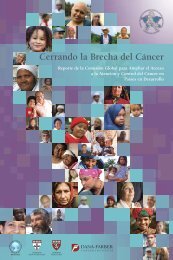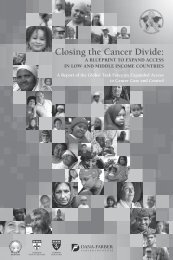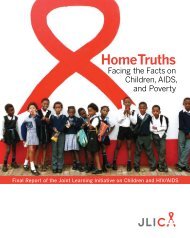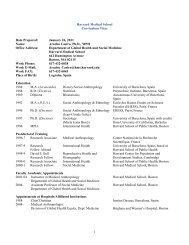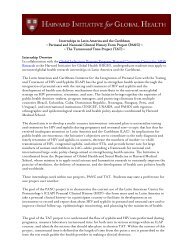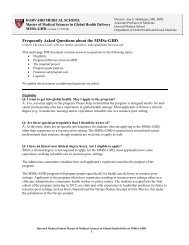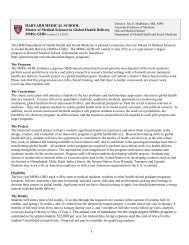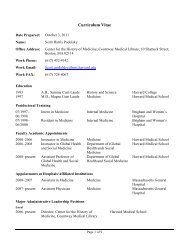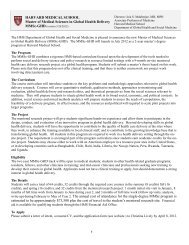Haiti Case Study - The Department of Global Health and Social ...
Haiti Case Study - The Department of Global Health and Social ...
Haiti Case Study - The Department of Global Health and Social ...
Create successful ePaper yourself
Turn your PDF publications into a flip-book with our unique Google optimized e-Paper software.
diarrhoea cases. <strong>The</strong>se investments would also have a beneficial long-term effect on a<br />
population's productivity <strong>and</strong> stability. 196 Obviously these investments would best come from<br />
the development community, but in states where there is a proven link between state stability<br />
<strong>and</strong> water security, nations could provide funding <strong>and</strong> resources channelled through an<br />
international stabilization force under its security m<strong>and</strong>ate—if funding <strong>and</strong> resources are not<br />
forthcoming through the appropriate development channels.<br />
38. In <strong>Haiti</strong>, the development community is not able to fully support water security<br />
development <strong>and</strong> the cholera epidemic has shown that water insecurity in this country<br />
impacted stability. In 2008 the Inter-American Development Bank estimated building<br />
municipal water treatment plants in <strong>Haiti</strong> would cost 750 million dollars. 197 However, because<br />
<strong>of</strong> scarce resources <strong>and</strong> funds available in the country, a large-scale water project appears<br />
unlikely in the near future—the consolidated appeal process for <strong>Haiti</strong> in 2011 received only<br />
55% <strong>of</strong> the requested amount. On the other h<strong>and</strong>, MINUSTAH with its engineering capacity,<br />
has assets that could provide clean water pumps <strong>and</strong> contribute to sewage cleaning, draining<br />
<strong>of</strong> water <strong>and</strong> garbage removal. It is not up to the military to decide when <strong>and</strong> where safe<br />
water projects need to be performed. In the case <strong>of</strong> <strong>Haiti</strong>, requests from local authorities <strong>and</strong><br />
foreign civilian organizations for MINUSTAH support should go to the JOTC.<br />
39. Finally, the other key tool in fighting the spread <strong>of</strong> cholera, <strong>and</strong> reducing causalities is<br />
direct health interventions in the form <strong>of</strong> prevention <strong>of</strong> infection through vaccination <strong>and</strong> rapid<br />
treatment with rehydration medicines. Such medical supplies require organized supply<br />
chains that can ensure they reach the affected areas. MINUSTAH helped with some medical<br />
supply distribution.<br />
Observations for <strong>Health</strong> System Strengthening<br />
40. Both the impact <strong>of</strong> <strong>and</strong> the solutions to the cholera outbreak extend much further than<br />
the boundaries <strong>of</strong> the health system as defined by the WHO. Whenever there are significant<br />
threats to the personal <strong>and</strong> environmental security <strong>of</strong> the population, any gains in health<br />
security can be quickly eroded. Improvements in the health system alone would not be<br />
sufficient to protect a population from future outbreaks <strong>of</strong> a waterborne infectious disease.<br />
41. What is needed within the health system, using the WHO building blocks as a<br />
framework, may include:<br />
a. Service Delivery: Ensure medical treatment facilities are able to maintain sanitary<br />
conditions <strong>and</strong> mortuary services can dispose <strong>of</strong> cadavers quickly <strong>and</strong> appropriately so<br />
that medical treatment facilities can function at full capacity. Ensure security is maintained<br />
at existing facilities <strong>and</strong> so that additional facilities can be built as necessary.<br />
b. <strong>Health</strong> Workforce: Ensure medical workers are trained to recognize, treat <strong>and</strong> report<br />
cholera cases.<br />
c. Information: Ensure a functional epidemic surveillance system is in place that makes<br />
use <strong>of</strong> new technology <strong>and</strong> security community information as well as traditional<br />
surveillance methods to provide early warning <strong>of</strong> a possible epidemic. Use mobile phone<br />
tracking <strong>and</strong> messaging to keep the public informed to complement traditional public<br />
information broadcasts.<br />
d. Medical Products, Vaccines & Technologies: Coordinate all available logistics<br />
mechanisms to ensure medical supply chains are able to meet sudden increased needs.<br />
e. Financing: Channel international funding to enable provision <strong>of</strong> epidemic treatment <strong>and</strong><br />
vaccines at no cost to the population.<br />
f. Leadership/Governance: Strengthen the ability <strong>of</strong> local health authorities to manage the<br />
epidemic response with experts from the international community.<br />
C-7



